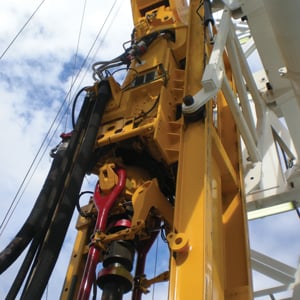Top drive encoders are mission critical. If you don’t want idle rigs sapping your profits, you need a clear understanding of the challenges and potential problems that can come to your operation.
Although top drive encoders are becoming more durable and reliable, there are still many problems that can arise. After all, a huge locomotive-grade electric motor meshed with a 750 ton capable gearbox is often left to depend on a rotary encoder’s glass disk, fragile electronics, and one tiny 40lb single-row bearing!

Let’s discuss why top drive rotary encoders fail: The first challenge that we’ll discuss is vibration. The top drive encoder experiences nearly continuous vibration during its operation. Drillstring dynamic motions such as bit-bounce, stick-slip, bending, and BHA whirl create dynamic forces on the encoder. Plus, site-to-site transportation of mobile rigs often causes 200G or more shock loads.
Another challenge is temperature cycling. The top drive forces huge temperature swings at the encoder as the rig is warmed up from potentially -50°C conditions and the motor heats the encoder to nearly 100°C. This hot and cold cycling is frequent, and brake drag can push encoder temperatures quickly over 150°C! These temperature cycles can cause direct electronic failures, but even more commonly cause seal failures in standard rotary encoders.
The environment is also a huge obstacle. There are oil and gas drills located all over the world, and the climates in which these minerals are drilled vary drastically. For instance, the drilling site can be 100% condensing humid, with salt water, ice, dirt, hydrocarbons and acids all present. When selecting your top drive encoder, variables such as climate and seasonal changes must be accounted for.
The bad news is that you can't do anything (or much of anything) about the causes of encoder failures on top drives. But you can do a lot about eliminating failures and detecting the few failures quickly and diagnosing accurately, to get your mean-time-to-repair the top drive down.
To learn more about the failure modes about encoders, follow the next in our series of blog posts on top drive encoders, or download our white paper:

